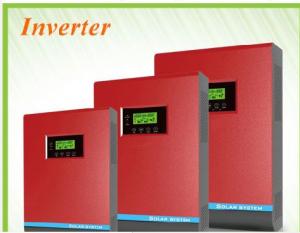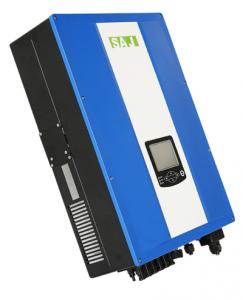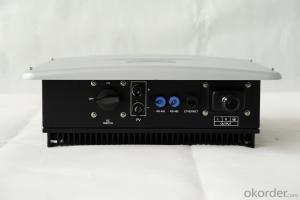1500 Watt Solar Inverter On Grid Suntrio-TL20K with 2 MPPT
- Loading Port:
- Guangzhou
- Payment Terms:
- TT OR LC
- Min Order Qty:
- 1 watt
- Supply Capability:
- 3000 watt/month
OKorder Service Pledge
OKorder Financial Service
You Might Also Like
Suntrio-TL12K/15K/17K/20K PV inverters are transformerless inverters with efficiency of up to 98.1%. Multi-MPPT inputs provides higher flexibility for the project installation. Stainless steel housing and IP65 protection guarantee use both indoor and outdoor for long. The series inverters are ideally suited for medium and commercial PV projects of up to MW range.
1. Leading technology
· Max. efficiency 98.1%
• MPPT accuracy up to 99.9% efficiency
• Compliant with VDE-AR-N 4105
2. User-friendly
• 5 inch LCD display with comprehensive information
• Embedded webserver monitoring
• Easy installation
3. Flexible
• Multi-country configuration
• RS485 / Ethernet / Wi-Fi communication
• Wide range of DC input voltage
• IP65 for indoor and outdoor
4. Certificates: TUV,SAA,G83,ISO9001,ISO14001,etc.
Futures
■ Two independent MPPT for flexible configuration.
■ Space Vector PWM to maximize efficiency and minimize EMI.
■ Highest MPPT performance, up to 99.9% efficiency.
■ Transformerless design with 98.1% Max. efficiency.
■ Ethernet/ Wi-Fi communication interface.
■ Integrated Web Server for overall performance monitoring.
■ Compliance with VDE-AR-N 4105 with reactive power control.
■ 5-inch large LCD display.
■ LCD day/month/year/total yield graphs display.
■ Event history lookup
■ Easy operation with 5 navigation buttons.

1. How long will my inquiry get response?
Your inquiry related to our products or prices will be replied within 24 hours.
2. Can I get professional service and suggestion?
Well-trained and experienced staffs to answer all your questions in fluent English.
3. Do you accept OEM or customized design?
OEM & ODM, any your customized lightings we can help you to design and put into product.
4. What if I need specific design?
Distributorship are offered for your unique design and some our current models.
- Q: Are there any noise emissions from a solar inverter?
- Yes, solar inverters do produce some noise emissions, although the level of noise is generally very low. The noise is primarily generated by the cooling fans and internal components, but it is usually not significant enough to cause any major disturbances.
- Q: Can a solar inverter be used with a string inverter system?
- No, a solar inverter cannot be directly used with a string inverter system. A solar inverter converts the direct current (DC) generated by the solar panels into usable alternating current (AC) electricity. On the other hand, a string inverter manages the output of multiple solar panels connected in series, converting the DC power from the panels to AC power for the grid. These two types of inverters serve different functions and are not compatible with each other.
- Q: How does the efficiency of a solar inverter affect the overall system performance?
- The efficiency of a solar inverter plays a critical role in determining the overall system performance. A higher efficiency inverter converts a greater percentage of the incoming solar energy into usable electricity, resulting in increased energy production. This ultimately leads to higher system output and improved performance. Additionally, a more efficient inverter reduces energy losses and improves the overall system's reliability and longevity. Lower efficiency inverters, on the other hand, can result in energy wastage and reduced system performance. Therefore, selecting a highly efficient solar inverter is essential for maximizing the overall performance and energy output of a solar power system.
- Q: Can a solar inverter be used with concentrated photovoltaic thermal systems?
- Yes, a solar inverter can be used with concentrated photovoltaic thermal (CPVT) systems. A solar inverter is used to convert the direct current (DC) generated by the CPVT system into alternating current (AC) that can be used to power electrical devices or be fed into the grid.
- Q: What are the key features to consider when purchasing a solar inverter?
- When purchasing a solar inverter, some key features to consider are the capacity and efficiency of the inverter, its compatibility with your solar panel system, the type of inverter technology used (such as string or microinverters), the warranty and reliability of the brand, and any additional features or smart capabilities offered by the inverter.
- Q: Can a solar inverter be used in three-phase systems?
- Yes, a solar inverter can be used in three-phase systems. In fact, three-phase solar inverters are commonly used in commercial and industrial applications where a three-phase power supply is available. These inverters are designed to convert the DC power generated by solar panels into AC power suitable for use in three-phase systems.
- Q: Can a solar inverter be connected to a backup battery system?
- Yes, a solar inverter can be connected to a backup battery system. This allows the solar energy generated during the day to be stored in the backup battery system and used during times when the sun is not shining or during power outages.
- Q: Can a solar inverter be used with a solar-powered electric gate system?
- Yes, a solar inverter can be used with a solar-powered electric gate system. The solar inverter is responsible for converting the DC power generated by the solar panels into AC power, which is required to operate the electric gate system. This allows the solar energy to be utilized efficiently in powering the gate system.
- Q: What is the maximum voltage input for a solar inverter?
- The maximum voltage input for a solar inverter typically depends on the specific model and manufacturer. However, in general, it ranges from around 600 to 1000 volts, with some higher-end models able to handle higher voltages.
- Q: What are the key factors affecting the compatibility of a solar inverter with other system components?
- The key factors affecting the compatibility of a solar inverter with other system components include the power rating and voltage compatibility of the inverter with the solar panels, batteries, and electrical grid, as well as the communication protocols and interconnectivity requirements between the inverter and other system components. Additionally, the inverter's efficiency, protection features, and overall design should be considered to ensure seamless integration and optimal performance of the entire solar power system.
Send your message to us
1500 Watt Solar Inverter On Grid Suntrio-TL20K with 2 MPPT
- Loading Port:
- Guangzhou
- Payment Terms:
- TT OR LC
- Min Order Qty:
- 1 watt
- Supply Capability:
- 3000 watt/month
OKorder Service Pledge
OKorder Financial Service
Similar products
Hot products
Hot Searches
Related keywords























